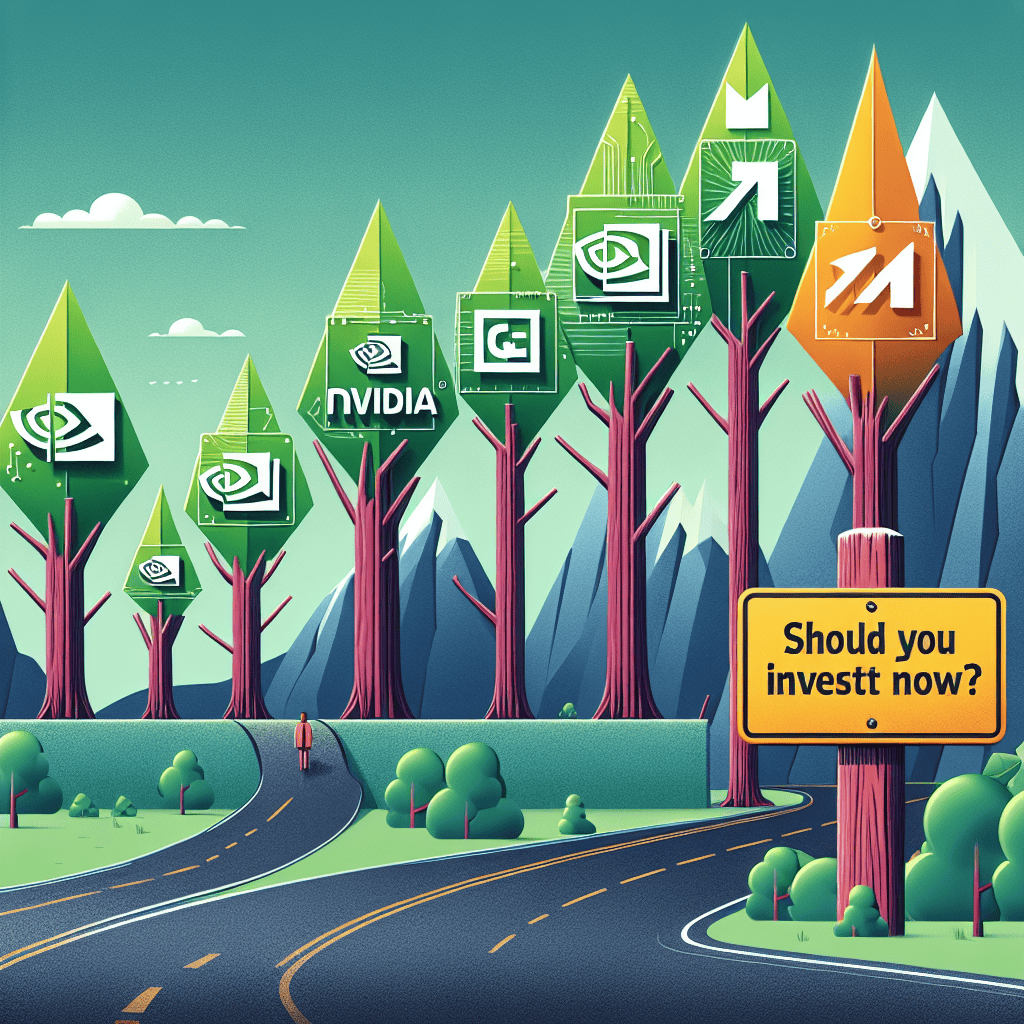“Riding the Tech Wave: Is Now the Time to Invest in Nvidia’s Momentum?”
Introduction
Nvidia, a leading player in the semiconductor industry, has recently experienced a significant surge in its stock value following the release of strong earnings reports from tech giants Apple and Amazon. This upward momentum in Nvidia’s stock price reflects broader investor optimism in the technology sector, driven by robust performance and growth prospects of major companies. As Nvidia continues to capitalize on its advancements in artificial intelligence, gaming, and data center technologies, potential investors are keenly evaluating whether this is an opportune moment to invest in the company. The decision hinges on Nvidia’s ability to sustain its growth trajectory amidst evolving market dynamics and competitive pressures.
Nvidia’s Market Performance: Analyzing the Post-Earnings Surge
Nvidia’s market performance has recently captured the attention of investors and analysts alike, particularly following the earnings reports from tech giants Apple and Amazon. The semiconductor company, known for its cutting-edge graphics processing units (GPUs) and artificial intelligence (AI) technologies, has experienced a notable surge in its stock price. This upward trajectory prompts a closer examination of the factors contributing to Nvidia’s recent success and whether it presents a viable investment opportunity at this juncture.
To begin with, Nvidia’s rise can be partially attributed to the broader tech sector’s performance, as evidenced by the earnings reports from Apple and Amazon. Both companies exceeded market expectations, which in turn bolstered investor confidence across the technology landscape. This positive sentiment has spilled over to Nvidia, as investors anticipate continued growth and innovation within the sector. Moreover, Nvidia’s strategic positioning in the AI and data center markets has further fueled optimism about its future prospects.
In addition to the favorable market conditions, Nvidia’s own financial performance has been impressive. The company has consistently reported strong revenue growth, driven by robust demand for its GPUs in gaming, professional visualization, and data center applications. Furthermore, Nvidia’s foray into AI has positioned it as a leader in this rapidly expanding field. The company’s AI platforms are increasingly being adopted across various industries, from healthcare to automotive, underscoring its potential for sustained growth.
Another factor contributing to Nvidia’s surge is its strategic acquisitions and partnerships. The company’s acquisition of Mellanox Technologies, a leader in high-performance computing and networking solutions, has strengthened its data center offerings. This move has not only expanded Nvidia’s product portfolio but also enhanced its competitive edge in the market. Additionally, Nvidia’s collaborations with major tech firms and research institutions have bolstered its reputation as an innovator and leader in the AI space.
Despite these positive developments, potential investors should also consider the challenges and risks associated with investing in Nvidia. The semiconductor industry is highly competitive, with rapid technological advancements and shifting consumer preferences. Nvidia faces competition from other major players such as AMD and Intel, which are also investing heavily in AI and data center technologies. Moreover, geopolitical tensions and trade disputes could impact Nvidia’s supply chain and market access, posing potential risks to its growth trajectory.
Furthermore, Nvidia’s stock valuation is another critical factor to consider. The recent surge in its stock price has led to a higher price-to-earnings (P/E) ratio, which may raise concerns about overvaluation. Investors should carefully assess whether the current stock price accurately reflects Nvidia’s growth potential and market position. Conducting a thorough analysis of the company’s financial health, competitive landscape, and future growth prospects is essential before making an investment decision.
In conclusion, Nvidia’s recent market performance, buoyed by positive earnings reports from Apple and Amazon, highlights its strong position within the tech sector. The company’s strategic focus on AI and data center technologies, coupled with its successful acquisitions and partnerships, underscores its potential for continued growth. However, investors should remain mindful of the competitive landscape and potential risks associated with the semiconductor industry. By carefully evaluating Nvidia’s financial metrics and market dynamics, investors can make informed decisions about whether to invest in this promising tech giant.
Apple and Amazon Earnings: Impact on Nvidia’s Stock
The recent earnings reports from tech giants Apple and Amazon have sent ripples through the stock market, with Nvidia emerging as a notable beneficiary. As investors digest the financial results of these industry leaders, Nvidia’s stock has experienced a significant surge, prompting many to consider whether now is the opportune moment to invest in the semiconductor powerhouse. To understand the dynamics at play, it is essential to examine the interplay between Apple and Amazon’s earnings and Nvidia’s market performance.
Apple’s earnings report, which exceeded Wall Street expectations, highlighted robust sales in its services and wearables segments, despite a slight dip in iPhone sales. This performance underscores Apple’s continued strength in diversifying its revenue streams, a strategy that has long-term implications for its supply chain partners, including Nvidia. As Apple continues to innovate and expand its product offerings, the demand for advanced semiconductor technology is likely to increase, benefiting companies like Nvidia that are at the forefront of graphics processing and AI capabilities.
Similarly, Amazon’s earnings report revealed impressive growth in its cloud computing division, Amazon Web Services (AWS), which remains a critical driver of the company’s profitability. AWS’s expansion is intrinsically linked to the demand for high-performance computing solutions, an area where Nvidia’s GPUs are indispensable. The increasing reliance on cloud services and AI-driven applications suggests a sustained demand for Nvidia’s cutting-edge technology, further bolstering its stock performance.
In light of these developments, Nvidia’s stock surge can be attributed to the broader optimism surrounding the tech sector, fueled by Apple and Amazon’s positive earnings. Investors are increasingly recognizing Nvidia’s pivotal role in enabling the technological advancements that underpin the success of these tech behemoths. Moreover, Nvidia’s strategic initiatives, such as its foray into the automotive industry with AI-driven solutions and its expansion into data centers, position it well to capitalize on emerging trends.
However, potential investors should also consider the inherent risks associated with investing in Nvidia at this juncture. The semiconductor industry is notoriously cyclical, with periods of rapid growth often followed by downturns. Additionally, Nvidia faces stiff competition from other semiconductor companies, which could impact its market share and profitability. Furthermore, geopolitical tensions and supply chain disruptions pose potential challenges that could affect Nvidia’s operations and stock performance.
Despite these risks, Nvidia’s strong financial position and innovative product pipeline provide a solid foundation for future growth. The company’s commitment to research and development ensures that it remains at the cutting edge of technology, while its strategic partnerships with industry leaders like Apple and Amazon enhance its market position. As such, Nvidia is well-equipped to navigate the challenges and opportunities that lie ahead.
In conclusion, the recent surge in Nvidia’s stock following Apple and Amazon’s earnings reports reflects the company’s integral role in the tech ecosystem. While the current market conditions present a compelling case for investment, potential investors should carefully weigh the risks and rewards. By considering Nvidia’s strategic positioning and the broader industry trends, investors can make informed decisions about whether to invest in this dynamic and influential company. As always, a diversified investment approach and a long-term perspective are advisable when navigating the complexities of the stock market.
Investment Strategies: Is Now the Right Time to Buy Nvidia?
Nvidia, a leading player in the semiconductor industry, has recently experienced a significant surge in its stock price, following the release of robust earnings reports from tech giants Apple and Amazon. This development has sparked considerable interest among investors, prompting many to consider whether now is the opportune moment to invest in Nvidia. To make an informed decision, it is essential to examine the factors contributing to Nvidia’s recent performance, the broader market context, and the potential risks and rewards associated with investing in the company.
The recent uptick in Nvidia’s stock can be attributed, in part, to the positive sentiment generated by Apple and Amazon’s earnings. Both companies reported strong financial results, which have bolstered investor confidence in the technology sector as a whole. Nvidia, being a key supplier of graphics processing units (GPUs) and other semiconductor products, stands to benefit from the continued growth and innovation within this sector. As demand for high-performance computing, artificial intelligence, and gaming technologies continues to rise, Nvidia’s products are increasingly in demand, positioning the company for sustained growth.
Moreover, Nvidia’s strategic initiatives and product innovations have further strengthened its market position. The company’s advancements in AI and machine learning, as well as its expansion into data centers and autonomous vehicles, have opened new avenues for revenue generation. These efforts have not only diversified Nvidia’s product portfolio but have also enhanced its competitive edge in the rapidly evolving tech landscape. Consequently, Nvidia’s ability to capitalize on emerging trends and maintain its leadership in the semiconductor industry makes it an attractive prospect for investors seeking long-term growth opportunities.
However, while Nvidia’s recent performance and strategic positioning are promising, potential investors must also consider the broader market dynamics and inherent risks. The semiconductor industry is characterized by rapid technological advancements and intense competition, which can pose challenges to even the most established players. Additionally, geopolitical tensions and supply chain disruptions have the potential to impact Nvidia’s operations and profitability. Therefore, investors should remain vigilant and assess these external factors when evaluating the company’s investment potential.
Furthermore, Nvidia’s stock valuation is another critical aspect to consider. The recent surge in its stock price has led to a higher valuation, which may raise concerns about overvaluation. Investors should carefully analyze Nvidia’s financial metrics, such as its price-to-earnings ratio and revenue growth projections, to determine whether the current stock price accurately reflects the company’s intrinsic value. Conducting a thorough valuation analysis can help investors avoid overpaying for the stock and ensure that their investment aligns with their financial goals.
In conclusion, Nvidia’s recent surge following Apple and Amazon’s earnings reports highlights the company’s strong market position and growth potential. Its strategic initiatives and product innovations have positioned it well to capitalize on emerging trends in the technology sector. However, potential investors should also consider the broader market context, including industry competition and geopolitical risks, as well as the company’s current valuation. By carefully weighing these factors, investors can make informed decisions about whether now is the right time to invest in Nvidia, balancing the potential rewards with the associated risks.
Nvidia’s Growth Potential: Key Factors Driving the Surge

Nvidia’s recent surge in the stock market has captured the attention of investors, particularly following the earnings reports from tech giants Apple and Amazon. This upward momentum can be attributed to several key factors that underscore Nvidia’s growth potential in the ever-evolving technology landscape. As the company continues to expand its influence across various sectors, understanding these driving forces is crucial for investors contemplating whether to invest in Nvidia now.
To begin with, Nvidia’s leadership in the graphics processing unit (GPU) market remains a cornerstone of its success. The company’s GPUs are renowned for their superior performance, which has made them indispensable in gaming, professional visualization, and increasingly, in data centers. The demand for high-performance computing solutions is on the rise, driven by the proliferation of artificial intelligence (AI) and machine learning applications. Nvidia’s GPUs are at the heart of these technologies, providing the computational power necessary to train complex AI models. This has positioned Nvidia as a critical player in the AI revolution, with its products being adopted by major tech companies and research institutions worldwide.
Moreover, Nvidia’s strategic acquisitions have bolstered its growth prospects. The acquisition of Mellanox Technologies, a leader in high-performance networking solutions, has enhanced Nvidia’s data center offerings. This move has allowed Nvidia to provide a more comprehensive suite of products that cater to the needs of modern data centers, which are increasingly reliant on fast and efficient data processing capabilities. Additionally, Nvidia’s acquisition of ARM Holdings, although still under regulatory scrutiny, promises to further expand its reach into the mobile and Internet of Things (IoT) markets. ARM’s energy-efficient chip designs are ubiquitous in smartphones and IoT devices, and integrating these with Nvidia’s technology could unlock new opportunities for innovation and growth.
Transitioning to another significant factor, Nvidia’s commitment to research and development (R&D) cannot be overlooked. The company consistently invests a substantial portion of its revenue into R&D, ensuring that it remains at the forefront of technological advancements. This dedication to innovation has resulted in a steady stream of cutting-edge products and solutions that meet the evolving needs of its customers. For instance, Nvidia’s recent advancements in real-time ray tracing technology have set new standards in the gaming industry, offering gamers unprecedented levels of realism and immersion.
Furthermore, Nvidia’s partnerships and collaborations with other industry leaders have played a pivotal role in its growth trajectory. By aligning with companies such as Microsoft, Google, and Amazon, Nvidia has been able to integrate its technology into a wide array of platforms and services. These collaborations not only expand Nvidia’s market reach but also reinforce its reputation as a trusted and reliable partner in the tech ecosystem.
In conclusion, Nvidia’s surge following the earnings reports of Apple and Amazon is underpinned by a combination of factors that highlight its robust growth potential. From its dominance in the GPU market and strategic acquisitions to its unwavering commitment to R&D and strategic partnerships, Nvidia is well-positioned to capitalize on emerging trends in technology. For investors considering whether to invest in Nvidia now, these factors provide a compelling case for the company’s continued success in the years to come. However, as with any investment, it is essential to conduct thorough research and consider potential risks before making a decision.
Comparing Tech Giants: Nvidia, Apple, and Amazon in 2023
In 2023, the technology sector continues to be a dynamic and rapidly evolving landscape, with companies like Nvidia, Apple, and Amazon at the forefront of innovation and market influence. Nvidia, in particular, has recently experienced a significant surge in its stock value following the release of strong earnings reports from Apple and Amazon. This development prompts investors to consider whether now is the opportune moment to invest in Nvidia, especially when comparing its performance and potential with that of its tech giant counterparts.
Nvidia’s rise can be attributed to its strategic positioning in the burgeoning fields of artificial intelligence (AI) and graphics processing units (GPUs). As AI becomes increasingly integral to various industries, Nvidia’s GPUs are in high demand for their ability to handle complex computations efficiently. This demand is further amplified by the growing interest in AI-driven applications, ranging from autonomous vehicles to advanced data analytics. Consequently, Nvidia’s robust product offerings and continuous innovation have positioned it as a leader in the tech industry, making it an attractive option for investors seeking growth opportunities.
Meanwhile, Apple and Amazon, both titans in their own right, have also reported impressive earnings, underscoring their resilience and adaptability in a competitive market. Apple’s success is largely driven by its ecosystem of products and services, which includes the iPhone, iPad, Mac, and a suite of digital services. The company’s ability to maintain a loyal customer base and consistently deliver high-quality products has solidified its status as a market leader. Furthermore, Apple’s foray into new areas such as augmented reality and health technology suggests a commitment to innovation that could yield substantial returns in the future.
Amazon, on the other hand, continues to dominate the e-commerce and cloud computing sectors. Its Amazon Web Services (AWS) division remains a significant revenue driver, providing scalable and reliable cloud solutions to businesses worldwide. Additionally, Amazon’s focus on expanding its logistics network and enhancing its Prime membership offerings has strengthened its competitive edge. The company’s ability to adapt to changing consumer preferences and invest in future growth areas, such as artificial intelligence and automation, further cements its position as a formidable player in the tech industry.
When comparing Nvidia to Apple and Amazon, it is essential to consider the unique strengths and market positions of each company. Nvidia’s specialization in GPUs and AI technology sets it apart as a key enabler of future technological advancements. In contrast, Apple and Amazon’s diversified portfolios and established market presence provide a level of stability and resilience that appeals to a broad range of investors.
For those contemplating an investment in Nvidia, it is crucial to weigh the potential risks and rewards. While Nvidia’s recent surge is promising, the tech industry is inherently volatile, and market conditions can change rapidly. Investors should consider their risk tolerance and investment goals before making a decision. Additionally, keeping an eye on Nvidia’s strategic initiatives and market trends will be vital in assessing its long-term growth potential.
In conclusion, Nvidia’s recent performance, bolstered by strong earnings from Apple and Amazon, highlights its potential as a compelling investment opportunity. However, as with any investment decision, careful consideration and due diligence are paramount. By comparing Nvidia’s strengths with those of Apple and Amazon, investors can make informed choices that align with their financial objectives and risk appetite.
Risk Assessment: Evaluating Nvidia’s Investment Viability
Nvidia’s recent surge in the stock market, following the earnings reports from tech giants Apple and Amazon, has captured the attention of investors worldwide. As these companies reported robust earnings, the ripple effect was felt across the tech sector, with Nvidia emerging as a notable beneficiary. This development prompts a critical evaluation of Nvidia’s investment viability, especially in the context of its current market dynamics and future prospects.
To begin with, Nvidia’s position as a leader in the semiconductor industry is well-established. The company’s innovative prowess, particularly in graphics processing units (GPUs), has been a driving force behind its sustained growth. As the demand for high-performance computing continues to rise, Nvidia’s products are increasingly integral to a range of applications, from gaming and data centers to artificial intelligence and autonomous vehicles. This diversification not only underscores Nvidia’s adaptability but also its potential for long-term growth.
However, while Nvidia’s technological advancements are impressive, potential investors must consider the inherent risks associated with the semiconductor industry. The sector is characterized by rapid technological changes and intense competition, with companies like AMD and Intel constantly vying for market share. This competitive landscape necessitates continuous innovation and substantial investment in research and development, which can strain financial resources and impact profitability.
Moreover, Nvidia’s recent stock surge, influenced by external factors such as Apple and Amazon’s earnings, highlights the volatility that can accompany tech investments. Market sentiment can be swayed by broader economic conditions, geopolitical tensions, and supply chain disruptions, all of which can affect Nvidia’s performance. For instance, the global semiconductor shortage has underscored the fragility of supply chains, posing challenges that could potentially hinder Nvidia’s ability to meet demand.
In addition to these industry-specific risks, investors should also consider Nvidia’s valuation. The company’s stock has experienced significant appreciation, leading to a high price-to-earnings (P/E) ratio compared to historical norms. While this reflects investor confidence in Nvidia’s growth prospects, it also raises questions about whether the stock is overvalued. High valuations can limit upside potential and increase vulnerability to market corrections, making it crucial for investors to assess whether Nvidia’s current price accurately reflects its intrinsic value.
Despite these challenges, Nvidia’s strategic initiatives offer promising avenues for growth. The company’s expansion into new markets, such as the metaverse and edge computing, demonstrates its commitment to staying at the forefront of technological innovation. Furthermore, Nvidia’s acquisition of Arm Holdings, pending regulatory approval, could significantly enhance its capabilities and market reach, providing a competitive edge in the evolving tech landscape.
In conclusion, while Nvidia’s recent market performance and strategic positioning present compelling reasons for investment, potential investors must conduct a thorough risk assessment. Evaluating factors such as industry competition, market volatility, and stock valuation is essential to making informed decisions. By balancing these considerations with Nvidia’s growth potential and strategic initiatives, investors can better gauge the company’s investment viability. Ultimately, whether to invest in Nvidia now depends on one’s risk tolerance and investment horizon, as well as a careful analysis of the broader market context.
Future Outlook: Nvidia’s Position in the Tech Industry
Nvidia, a leading player in the semiconductor industry, has recently experienced a significant surge in its stock price, following the release of strong earnings reports from tech giants Apple and Amazon. This development has sparked renewed interest among investors, prompting many to consider whether now is the right time to invest in Nvidia. To understand Nvidia’s future outlook, it is essential to examine its current position in the tech industry and the factors contributing to its recent success.
Nvidia’s rise can be attributed to its strategic positioning in several high-growth areas, including artificial intelligence (AI), gaming, and data centers. The company’s graphics processing units (GPUs) are renowned for their superior performance, making them the preferred choice for AI applications and gaming enthusiasts. As AI continues to permeate various sectors, from healthcare to autonomous vehicles, Nvidia’s GPUs are increasingly in demand, providing a robust foundation for future growth.
Moreover, the gaming industry has witnessed a surge in popularity, partly due to the global pandemic, which has driven more people to seek entertainment at home. Nvidia’s GPUs are integral to delivering high-quality gaming experiences, and the company’s recent launch of its GeForce RTX 30 series has been met with enthusiasm from the gaming community. This product line promises enhanced performance and realism, further solidifying Nvidia’s dominance in the gaming sector.
In addition to AI and gaming, Nvidia’s data center business has emerged as a significant growth driver. The shift towards cloud computing and the increasing need for data processing capabilities have fueled demand for Nvidia’s data center solutions. The company’s acquisition of Mellanox Technologies in 2020 has bolstered its data center offerings, enabling it to provide comprehensive solutions that cater to the evolving needs of businesses worldwide.
While Nvidia’s current position appears strong, it is crucial to consider potential challenges that may impact its future trajectory. The semiconductor industry is highly competitive, with companies like AMD and Intel vying for market share. Nvidia must continue to innovate and maintain its technological edge to stay ahead of its rivals. Additionally, supply chain disruptions and geopolitical tensions could pose risks to Nvidia’s operations, potentially affecting its ability to meet growing demand.
Despite these challenges, Nvidia’s strategic investments and partnerships position it well for sustained growth. The company’s collaboration with leading tech firms, including its recent partnership with Amazon Web Services to offer AI infrastructure, underscores its commitment to expanding its reach and capabilities. Furthermore, Nvidia’s focus on research and development ensures that it remains at the forefront of technological advancements, paving the way for future innovations.
In conclusion, Nvidia’s current position in the tech industry is characterized by strong growth prospects, driven by its leadership in AI, gaming, and data centers. While challenges exist, the company’s strategic initiatives and partnerships provide a solid foundation for continued success. For investors considering Nvidia, it is essential to weigh the potential risks against the opportunities presented by its innovative product offerings and expanding market presence. As the tech landscape continues to evolve, Nvidia’s ability to adapt and capitalize on emerging trends will be crucial in determining its long-term success.
Q&A
1. **Why did Nvidia’s stock surge post Apple and Amazon earnings?**
Nvidia’s stock surged due to positive market sentiment and investor confidence following strong earnings reports from major tech companies like Apple and Amazon, which often influence the tech sector’s performance.
2. **How do Apple and Amazon’s earnings impact Nvidia?**
Strong earnings from Apple and Amazon can boost overall investor confidence in the tech sector, leading to increased interest and investment in other tech stocks like Nvidia.
3. **What are the key factors driving Nvidia’s growth?**
Nvidia’s growth is driven by its leadership in graphics processing units (GPUs), advancements in AI and machine learning, data center expansion, and its role in emerging technologies like autonomous vehicles.
4. **What risks should investors consider before investing in Nvidia?**
Investors should consider risks such as market volatility, competition from other tech companies, potential regulatory challenges, and the cyclical nature of the semiconductor industry.
5. **How does Nvidia’s valuation compare to its peers?**
Nvidia’s valuation is often higher than its peers due to its strong growth prospects and leadership in key technology areas, but investors should assess whether this premium is justified based on future earnings potential.
6. **What is the outlook for Nvidia in the near future?**
The outlook for Nvidia remains positive, with continued demand for its products in gaming, AI, and data centers, though macroeconomic factors and supply chain issues could impact performance.
7. **Should you invest in Nvidia now?**
Whether to invest in Nvidia depends on individual financial goals, risk tolerance, and market analysis. Potential investors should conduct thorough research and consider consulting a financial advisor.
Conclusion
Nvidia’s recent surge following Apple and Amazon’s earnings highlights its strong position in the tech sector, driven by robust demand for its GPUs and AI technologies. While the positive momentum suggests potential for further growth, investors should consider the broader market conditions, Nvidia’s valuation, and potential risks such as supply chain challenges and competition. Conducting thorough research and assessing personal investment goals and risk tolerance is crucial before making any investment decision.





